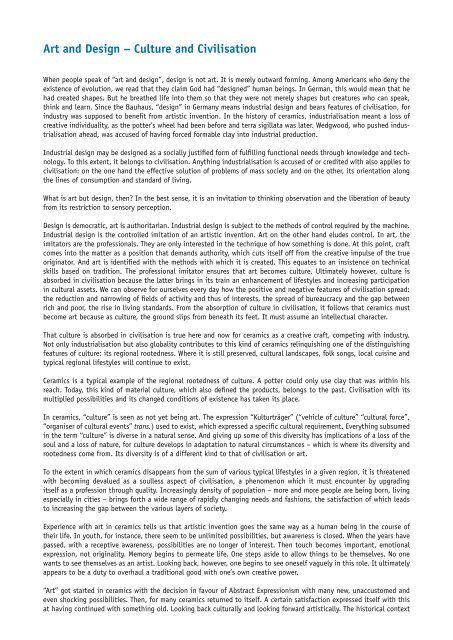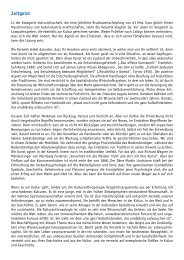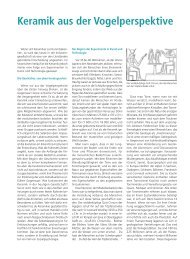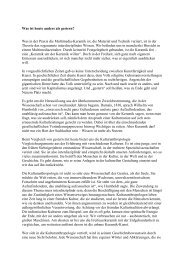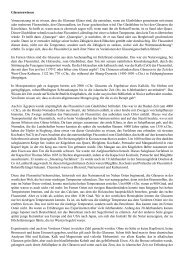download essay
download essay
download essay
Create successful ePaper yourself
Turn your PDF publications into a flip-book with our unique Google optimized e-Paper software.
Art and Design – Culture and Civilisation<br />
When people speak of “art and design”, design is not art. It is merely outward forming. Among Americans who deny the<br />
existence of evolution, we read that they claim God had “designed” human beings. In German, this would mean that he<br />
had created shapes. But he breathed life into them so that they were not merely shapes but creatures who can speak,<br />
think and learn. Since the Bauhaus, “design” in Germany means industrial design and bears features of civilisation, for<br />
industry was supposed to benefit from artistic invention. In the history of ceramics, industrialisation meant a loss of<br />
creative individuality, as the potter’s wheel had been before and terra sigillata was later. Wedgwood, who pushed industrialisation<br />
ahead, was accused of having forced formable clay into industrial production.<br />
Industrial design may be designed as a socially justified form of fulfilling functional needs through knowledge and technology.<br />
To this extent, it belongs to civilisation. Anything industrialisation is accused of or credited with also applies to<br />
civilisation: on the one hand the effective solution of problems of mass society and on the other, its orientation along<br />
the lines of consumption and standard of living.<br />
What is art but design, then? In the best sense, it is an invitation to thinking observation and the liberation of beauty<br />
from its restriction to sensory perception.<br />
Design is democratic, art is authoritarian. Industrial design is subject to the methods of control required by the machine.<br />
Industrial design is the controlled imitation of an artistic invention. Art on the other hand eludes control. In art, the<br />
imitators are the professionals. They are only interested in the technique of how something is done. At this point, craft<br />
comes into the matter as a position that demands authority, which cuts itself off from the creative impulse of the true<br />
originator. And art is identified with the methods with which it is created. This equates to an insistence on technical<br />
skills based on tradition. The professional imitator ensures that art becomes culture. Ultimately however, culture is<br />
absorbed in civilisation because the latter brings in its train an enhancement of lifestyles and increasing participation<br />
in cultural assets. We can observe for ourselves every day how the positive and negative features of civilisation spread:<br />
the reduction and narrowing of fields of activity and thus of interests, the spread of bureaucracy and the gap between<br />
rich and poor, the rise in living standards. From the absorption of culture in civilisation, it follows that ceramics must<br />
become art because as culture, the ground slips from beneath its feet. It must assume an intellectual character.<br />
That culture is absorbed in civilisation is true here and now for ceramics as a creative craft, competing with industry.<br />
Not only industrialisation but also globality contributes to this kind of ceramics relinquishing one of the distinguishing<br />
features of culture: its regional rootedness. Where it is still preserved, cultural landscapes, folk songs, local cuisine and<br />
typical regional lifestyles will continue to exist.<br />
Ceramics is a typical example of the regional rootedness of culture. A potter could only use clay that was within his<br />
reach. Today, this kind of material culture, which also defined the products, belongs to the past. Civilisation with its<br />
multiplied possibilities and its changed conditions of existence has taken its place.<br />
In ceramics, “culture” is seen as not yet being art. The expression “Kulturträger” (“vehicle of culture” “cultural force”,<br />
“organiser of cultural events” trans.) used to exist, which expressed a specific cultural requirement. Everything subsumed<br />
in the term “culture” is diverse in a natural sense. And giving up some of this diversity has implications of a loss of the<br />
soul and a loss of nature, for culture develops in adaptation to natural circumstances – which is where its diversity and<br />
rootedness come from. Its diversity is of a different kind to that of civilisation or art.<br />
To the extent in which ceramics disappears from the sum of various typical lifestyles in a given region, it is threatened<br />
with becoming devalued as a soulless aspect of civilisation, a phenomenon which it must encounter by upgrading<br />
itself as a profession through quality. Increasingly density of population – more and more people are being born, living<br />
especially in cities – brings forth a wide range of rapidly changing needs and fashions, the satisfaction of which leads<br />
to increasing the gap between the various layers of society.<br />
Experience with art in ceramics tells us that artistic invention goes the same way as a human being in the course of<br />
their life. In youth, for instance, there seem to be unlimited possibilities, but awareness is closed. When the years have<br />
passed, with a receptive awareness, possibilities are no longer of interest. Then touch becomes important, emotional<br />
expression, not originality. Memory begins to permeate life. One steps aside to allow things to be themselves. No one<br />
wants to see themselves as an artist. Looking back, however, one begins to see oneself vaguely in this role. It ultimately<br />
appears to be a duty to overhaul a traditional good with one’s own creative power.<br />
“Art” got started in ceramics with the decision in favour of Abstract Expressionism with many new, unaccustomed and<br />
even shocking possibilities. Then, for many ceramics returned to itself. A certain satisfaction expressed itself with this<br />
at having continued with something old. Looking back culturally and looking forward artistically. The historical context
from which it was created it what is new. Love of the past is something quite different for the ceramist than it is for<br />
everyone who is not a ceramist. It is a matter of consciousness, not of following. As artists in the modern era, if we<br />
reject tradition, we mean that history does not determine what we do but on the contrary, that we influence history.<br />
If so much gets lost, the change does not imply a loss but a rejuvenation. Loss has a character of its own.<br />
In ceramics, art is moved by subjectivity. It is a space that permits expansion. The new things that are created seem to<br />
correspond to a poetic of valediction, but it enlarges the vocabulary that either way ends in silence.<br />
Subjectivity, Individuality and Self-Fulfilment<br />
In terms of art, these are the three key expressions that apply to the individual. The individual (the subject) has his<br />
own nature, and we can say of the work, i.e. of the object, that it is distinct from all others as an expression of this<br />
one subjective individual. If a work surprises us by being unusual, we say, “That’s just his opinion”, and we mean the<br />
artist, the creative subject.<br />
In contrast, we are familiar with individuality as the opposite of collectivism. It means that everyone is different, even<br />
if everyone is equal. Equality is at the core; diversity is the colouring. To this extent, we have a colourful age at the<br />
moment, an age of individuality. The individual is at the centre, not the community; thus, there is diversity. This is<br />
where the individual feels the need of uniqueness. To have this sense of uniqueness confirmed by others or in the media<br />
means social recognition.<br />
Self fulfilment is based on finding oneself. This process is never complete as one is subject to continuing development.<br />
For the search for one’s inner destiny, it is the case that the path is the destination because individual abilities become<br />
perfected along the way. Everyone senses the indeterminacy and infinity of their individuality. Georg Simmel, who studied<br />
all of these problems, (“Das individuelle Gesetz” – approximately: “The indidual Law” – Frankfurt, Suhrkamp 1987)<br />
spoke of growing from one’s own roots. For ceramics as a field of activity, self fulfilment has a special meaning because<br />
it expresses itself in real objects that are subjective and individual.


